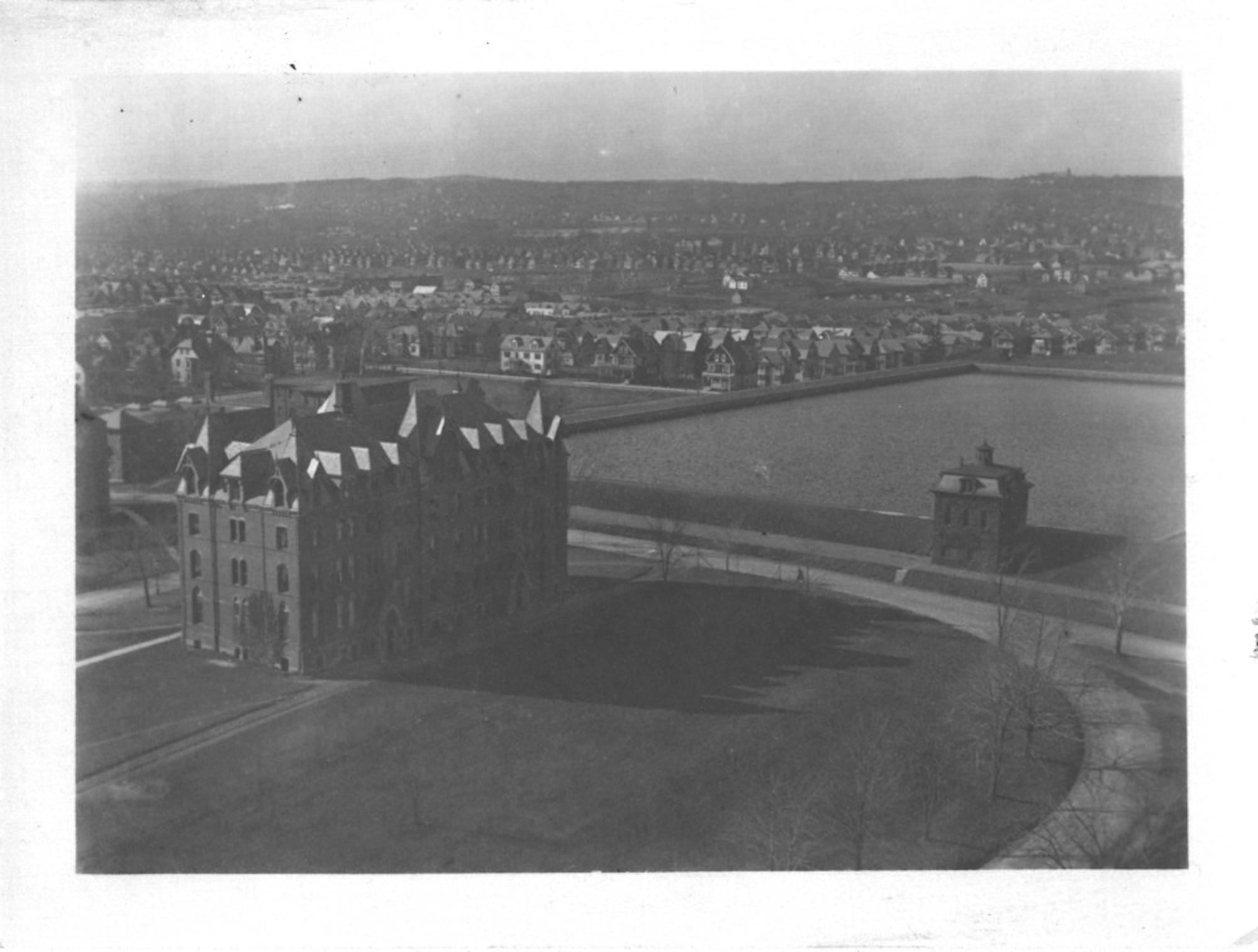All that is left of the Mystic Reservoir that previously occupied 4.5 acres of Tufts’ campus is the muddy field known as the residential quad. But between 1864 and 1948, the reservoir was used as a water supply, a picnic spot, a swimming hole, an ice rink and the centerpiece for countless campus traditions.
The "Rez," as it was known, was built in 1864 as part of the Mystic Water Works project to serve as a water source for the expanding population of Boston and its surrounding suburbs. The water was pumped from the Mystic River and held at the top of the hill so it could be easily distributed throughout the area. According to an article by Russell Miller published in the Winter 1988 issue of Criterion, 350 men used oxen to help dig the rectangular pit and line it with bricks.
Professor of GeologyJack Ridge said that it is likely that the bricks used were made in Medford.
“They had a big brickmaking industry here in Medford, and they made pottery,” Ridge said. “They used to make this really fine light-grey/white porcelain which requires real small particles, but most places they just made bricks. The bricks that they manufactured here, a lot of them were yellow: Paige Hall is made from those bricks.”
A pump house was built near West Hall and a groundskeeper who oversaw the property lived nearby. Part of an iron fence built in 1919 (one of many that were built around the reservoir over the years) can still be found near the tennis courts.
Although the reservoir was not yet part of Tufts’ campus, Miller writes that during World War I the college was authorized to use the embankment around it for the Student Army Training Corps' commando training.
“A section of trench was also built, but like the storming of an embankment, its use was never a very popular exercise,” Miller writes.
The embankment was also a popular spot for families to walk on Sundays and for couples to wander in the evenings. According to Miller, legend has it that girls who were asked on a date at the top of the pump house steps could never refuse.
One of the most popular stories about the Rez involves two couples who met on a walk there. The two boys, one a freshman and the other a senior, got in a fight and the senior ended up in the water. According to a "historical feature" by Jules Wagman (A ‘48) published in the 1946 issue of the literary magazine Tuftonian, after the fight, the Rez was off limits to first-years to preserve seniors’ honor.
The Sword and Shield, founded in 1902, was an honors society responsible for upholding campus traditions such as this one. Both Wagman and Miller write that first-years were frequently dumped in the Rez as a joke or to punish them for not following campus customs.
Wagman writes that events at the Rezincluded Campus Sings, in which everyone gathered to sing the school’s hymns on the embankment. The orchestra and choir also gave concerts there when the weather was nice. When it froze, students would ice skate in spite of rules that prohibited it, according to Miller.
Eventually, pollution from nearby tanneries caused The Metropolitan District Commission to stop using the reservoir for drinking water in 1898. According to Miller, it was designated as an emergency water source in 1914. Pranks by Tufts students continued, and the pump house steps as well as the fence were damaged by fires and other acts of vandalism several times over the years. The reservoir was drained periodically after it stopped serving as a water source. During one of these drainings, a 38-caliber revolver was discovered and reportedly linked to a murder that remains unsolved, Miller writes.
Wagman writes that in 1944 the Rez was drained because the public was concerned about a number of drownings and suicides that had happened there recently. It became nothing more then a liability for the Commission, and a year later Tufts purchased the land for $1.
According to Miller, there were a number of suggestions for what to do with the empty pit. Some wanted to turn it into a football stadium, since the dimensions of its bottom were almost exactly the correct size for a field. Others wanted to make it an art complex, and rumors also circulated that it would be turned into a giant swimming pool.
By 1948, writes Miller, it was filled in and turned into a grass parking lot for 450 vehicles. Carmichael Hall was built at one end, with construction beginning in 1952 and ending in 1954. As more dorms were constructed in the ensuing decades -- Miller in 1959 and Houston in 1962 -- the field eventually became the residential quad.
Because of the sediment used to fill the pit, the area drained poorly. Ridge, who has taught at Tufts for 30 years, remembers spring as a particularly muddy time.
“There used to be a puddle out there," he said. "These guys from the dorm used to go out and play rugby in it and get really dirty. It must have been fun; they weren’t doing it just because they had to.”
After all these years, the spot where the Rez sat still marks the coming of spring – but now, instead of jumping in the water to cool off, students dive in the mud to catch a Frisbee after the snow finally melts.
History on the Hill: Tufts' reservoir

The land that is now residential quad, shown here in 1890, was once a reservoir that provided drinking water for the surrounding area.





